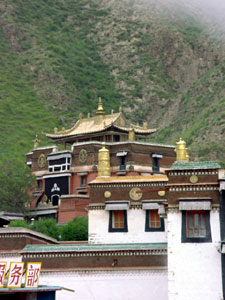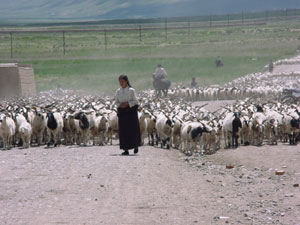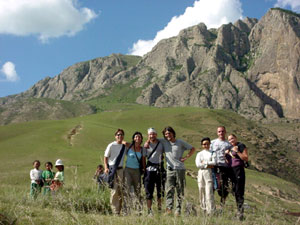![]()
| Gansu, China | Xiahe | 2002.07.15 - 07.23 |
Labrang Monastery
260 km south of the Gansu capital of Lanzhou is the peaceful Yellow-hat sect Buddhist monastery town of Xiahe. Situated at an altitude of 2905 meters (9530 feet) and surrounded by walking trails up beautiful hilly grasslands, many tourists arriving from low altitude with the intension of immediately exploring the area find themselves winded and lacking energy. The highlight of the town is the Labrang Monastery. The monastery itself occupies a 7 sq km space. North of the monastery is the Han Chinese section of Xiahe. South of the monastery is entirely inhabited by Tibetans. The Tibetans, with animal skin clothes, necklaces of orange coral, large sunglasses, and cowboy hats, motorcycle the dusty streets, giving the town a wild-west feel among the thousands of maroon-clothed monks and Buddhist pilgrims. A quick 1 or 2 day stop in Xiahe gives a superficial visual impression of the town. Longer stays give a general sense of the ambience. This town grows on you. The longer your stay, the more difficult it is to leave.
LABRANG MONASTERY
Circled by a 3-km long pilgrim path with prayer wheels, stupas, Tibetan stone
carvings, and miniature temples, Labrang Monastery houses numerous schools
of Buddhism, monk residences, prayer halls, museums, and temples. Walking
through the monastery and around the 3-km pilgrim circuit are both enjoyable,
even on the 3rd or 4th go. Entry into the monastery buildings is restricted
and must be as part of a paid tour guided by a monk. The ticket cost is
¥24. No student discount.
We joined a tour through the monastery buildings, prepared with white prayer scarves we collected in Nepal or Tibet. Breaking from the tour to offer our scarves resulted in a scolding by a monk we thought was asleep against an interior pillar. The restriction to free access is the most extreme of any monastery we have visited. To whom do we ask the reason?
Like all Buddhist monasteries, the building interiors are dimly lit but lavishly decorated. The scent of burning yak butter candles pervades the air. Colorfully embroidered silk and colored prayer scarves drape large Buddha figures. Walls are painted with Buddhas, protectors, and disciples. Our visit was enjoyable. We gave our offerings with the approval of the monk guard once he understood why we wanted to break from our group for a few minutes.
At the monastery, we hoped to view a prayer session. Nope. This week the monks are on vacation to party on the grasslands. Monks have vacation? And how do monks party? Interesting.
WALKS
Trails ascending the surrounding hills arrive at green animal feeding pastures,
a stupa, or a Tibetan tent settlement. Hiking up the hill behind the Labrang
Monastery gave of an excellent view of the entire complex. 2 child monks
were playing up here. They loved our digital camera and quickly learned how
to operate it. They shot a hour of blurry photos and unsteady video of
each other with glee.
TOWN FACILITIES
Xiahe is basic but has enough facilities to keep the foreign traveler comfortable.
Hotels have hot water in the morning and evenings. 2 Internet Cafes on the main road
offer about a 40kbps connection for ¥3 per hour. The Internet Cafe nearest Tara
Guesthouse let us network our laptop to their LAN. Budget accommodation at Tara Guesthouse
is comfortable. Higher-end accommodation is available 2 doors down. The Everest Cafe
serves delicious food prepared by a Nepali chef and showed up to Xiahe and decided
not to leave. Roadside fruit vendors are honest. Xiahe is also an excellent place to
stay long-term to study Buddhist religion and Tibetan language.
GANJIA GRASSLANDS
Near Xiahe are 2 outings to the grasslands. One is the Sanke Grasslands 20km distant.
Travelers reported disappointment with Sanke because of the Chinese tour groups and
"a large pink hotel in the middle of the grasslands." The other area is
called Ganjia Grasslands 35km distant. We hired a taxi with a group of backpackers
and headed for Ganjia.
Hotels in Xiahe sell 1-day tours to Ganjia Grasslands for ¥60 per person (minimum 4). Alternatively, a mini-van taxi can be hired for the full day for ¥200. Because we were a group of 7, hiring a mini-van and departing at our leisure was the better option. After a late leisurely breakfast, Lasse (Danish) and Robert (German) both of whom we first met in Beijing, Kristina (US), Stine (Belgian), Philippe (Belgian) and we flagged down a mini-van and were on our way. The mini-van driver knew the typical tourist route through the Ganjia Grasslands to a monastery and holy cave. Before exiting Xiahe, he wisely loaded a spare tire into the van.
27km later, we had our 2nd flat tire. Having already used the one spare, we were idle in a small Tibetan town in the middle of the grasslands. This is when having a group of travelers with similar mentality is a real advantage. Nobody was upset or complaining. Our first thought was to have lunch at the local Muslim restaurant while we waited for a tire delivery from Xiahe. The driver thought we had 2 hours of wait time. After lunch, with no tire in sight, Robert and Kristina explored the town, Masami walked in the grasslands, and Wes, Stine, Lasse, and Philippe joined an informal basketball game with some Tibetans. Running at 3000 meters isn't easy. We foreigners were soon gasping for breath, lungs burning while the little 10-year old Tibetan boy outscored all 4 of us combined. How embarrassing. Wes was saved by Masami. She returned from the grasslands urging everyone to go for a beautiful walk. The others remained for some more basketball as we were joined by Robert and Kristina for a lengthy walk towards the hills. Our driver remained at the restaurant waiting for his tire delivery. The 4 walkers decided to continue towards the interesting-looking rock formations many kilometers distant. "What's the worst that could happen?" we decided. In the worst case, a new tire would arrive, the others would give up searching for us, and we'd hire some Tibetans with motorbikes to drive us back to Xiahe. We continued on through undulating fields of greenery. In the middle of nowhere, some Tibetan men on motorcycles stopped to talk to us. Even with a language barrier, we understood general concepts: further up the hill was their home, one seemed to want to marry Kristina, and all wanted photos we took mailed to them. After a general pow-wow of showing jewelry, hugging, and the men comparing belly-button hair, they continued on their errands and we decided to return to the car. As we stood up to return, a white van approached. "Hey, that looks like our mini-van." "And that looks like Lasse hanging out the window waving to us." It was 16:00, 4 hours since halting because of the second flat tire. But now we were on our way to the holy cave.
The mini-van we hired had little power. Each uphill stretch of dirt road required us to get out to lessen the weight in the vehicle. Feeling carefree and elated to be wandering through the grasslands, we often detoured along our walks. Prior to reaching the holy cave, we found a group of Tibetans juggling a soccer ball beside a stream. The detour to join them took another 30 minutes while our driver patiently waited at the end of the road. 4 of our group went to the cave. (Admission ¥15.) Masami, Lasse, and I preferred to climb some nearby rocks for a view of the valley.
45 minutes later, the 4 cave explorers emerged muddy and laughing. They reported that the cave experience was an adventure. There wasn't much to see, but slipping down muddy shafts was "fun". We were happy to pass.
At 19:00 we returned to the mini-van and collectively decided to skip the monastery and try to return to Xiahe before the restaurants closed at 21:30. We didn't make it. Fortunately, the kind Nepali chef at the Everest Cafe agreed to re-open the kitchen to cook the 7 of us vegetable Dal Bhat.
GETTING THERE
From the north, a direct bus departs Lanzhou for Xiahe at 06:30 and 14:00. In addition,
regular buses from Lanzhou travel to Linxia (at the ½ way point) and connect
with other regular buses that continue to Xiahe. The direct Lanzhou-Xiahe buses are
much faster than the shorter distance Lanzhou-Linxia and Linxia-Xiahe buses, as we learned
the hard way.
From the south, buses travel from Langmusi to Xiahe.
 |
This enormous Labrang Monastery occupies the center of Xiahe. Today there are 1400 full-time monks. The 1-story square structures in the foreground are monk residences. Each has a center courtyard. The taller buildings are schools and prayer halls. Green hills surround the town. |
 |
The decor of Labrang Monastery prayer halls is identical to those in Tibet. Golden deer and prayer wheels adorn the golden roofs. |
 |
A Tibetan pilgrim walks the 3-km pilgrim circuit that circles the Labrang Monastery complex. |
 |
Goats are herded through the small Tibetan town in the middle of Ganjia Grasslands where we stopped for hours due to a second flat tire. |
 |
Left to right: Wes, Stine, Robert, Philippe, Masami, Lasse, Kristina. We detour on a walk towards the holy cave to take some photos of our travel group. |
 |
While we wait for 4 of our travel group to emerge from the holy cave, Masami poses in front of a beautiful valley visible from atop a rocky hill we climbed. |
Copyright © 2000-2002 Wes and Masami Heiser. All rights reserved.